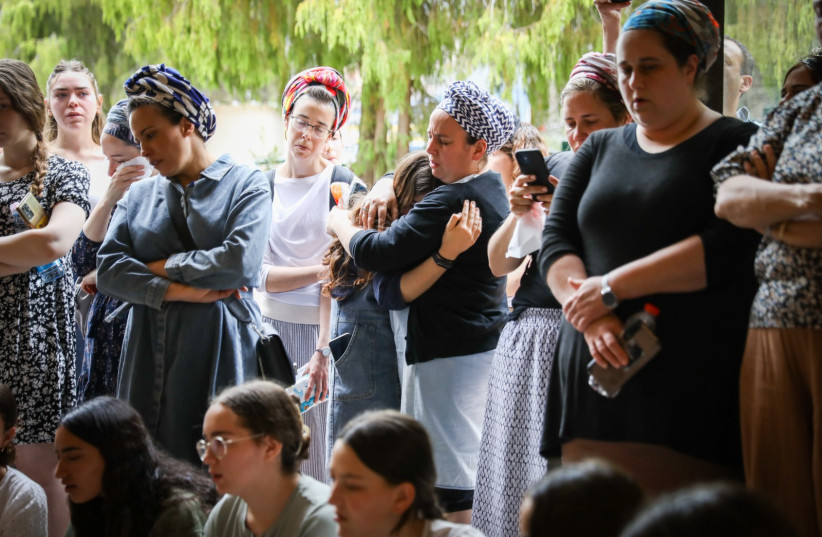The predictions were ominous.
After a tumultuous week in which Israel experienced rocket fire from Gaza, Lebanon and Syria; deadly terror attacks in the Jordan Valley and Tel Aviv and violent clashes between security forces and Palestinians on the Temple Mount, all eyes turned to Jerusalem as a potential and likely vortex of unrest.
Sunday was supposed to be the day when everything exploded, figuratively and literally. The first of Passover’s intermediate days, it was the day on which Jewish, Muslim and Christian worshipers would converge en masse in the Old City, as the traditional Priestly Blessing (Birkat Kohanim) coincided with Easter Sunday ceremonies, Ramadan prayers and the ascent of Jews to the Temple Mount.
The compound surrounding al-Aqsa Mosque has been at the center of an ongoing crisis that began last week when Israel Police officers raided the mosque to remove Palestinian youths, armed with rocks and incendiary devices, who were barricaded inside.
Footage of the raid triggered a furious reaction across the Arab and Muslim world and was exploited by terrorist groups as a pretext for the rocket attacks on Israel, which drew limited retaliation by the IDF.
Sunday’s volatile mix of humanity amid the already heightened tensions and massive police presence were the ingredients for a disaster waiting to happen.

Pope Francis, in his Easter address from St. Peter’s Square in the Vatican, expressed the worry felt by many.
“On this day, Lord, we entrust to you the city of Jerusalem… I express deep worry over the attacks of these last few days that threaten the hoped-for climate of trust and reciprocal respect needed to resume the dialogue between Israelis and Palestinians, so that peace may reign in the Holy City and in the entire region,” he said.
With potential flashpoints at every turn on Sunday, what could go wrong?
Well, it turned out, nothing.
Bucking all odds and predictions, the holy day passed with no notable altercations. More than 800 Jewish worshipers made the pilgrimage to the Temple Mount on Sunday morning, a 43% increase over the number of worshipers visiting the site during Passover last year.
At the same time, more than 15,000 Jews participated in the Birkat Kohanim at the Western Wall. Israel’s chief rabbis attended the blessing, which concluded with a special prayer for unity among the Jewish people.
In the Christian Quarter, thousands of pilgrims crowded into the narrow alleyways and were ushered through the courtyard of the Church of the Holy Sepulchre. Perhaps one of those pilgrims would have been Alessandro
Parini, an Italian tourist who was run over and killed by a terrorist on the Tel Aviv Promenade on Friday night. We may never know.
Israel continues to act as a comforting religious space for many faiths
Sunday’s event demonstrated how the world’s holiest city can accommodate worshipers intent on practicing their religion in an open and nonthreatening environment.
Israel’s mantra since reuniting Jerusalem in 1967 has been that freedom of religion is sacrosanct, and every government since has committed to maintaining the city as a beacon of openness and accommodation.
The Jerusalem Post’s Peggy Cidor witnessed the scene on Sunday. “The traditional blessing of the priests is over, as is the call to midday Muslim prayer from al-Aqsa Mosque – and by now, groups of Christian pilgrims are beginning to arrive at the [Western Wall] square, with guides who explain in a mixture of languages,” she wrote.
“A group of Bnei Menashe of the Indian subcontinent stands nearby and listens to the same explications [as] a group of Christian Indian women dressed in colorful traditional saris and wearing crosses made of gold.”
The vast majority of those who converged on the Old City on Sunday were not interested in anything besides practicing their faith.
When the extremists in their midst are muted, the doors open for the kind of coexistence that is the destiny of the city’s diverse population and the tourists and pilgrims who flock to the city from around the world.
It is possible that Sunday was an aberration that will be shattered by the return of unrest.
But for one day, at least, we could see how the ideal of Jerusalem as a city of peace and mutual respect can be realized. It was a snapshot of how this hallowed land, cherished by so many, can truly be the city of peace.